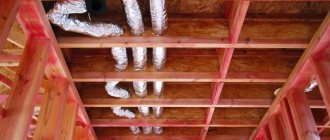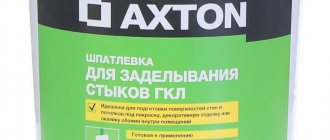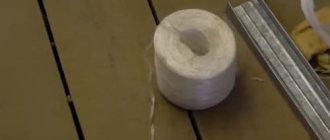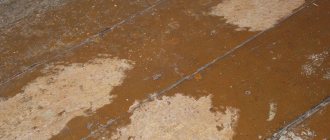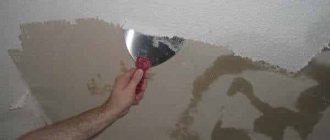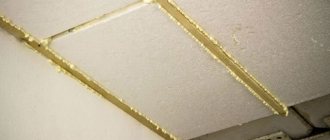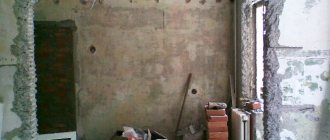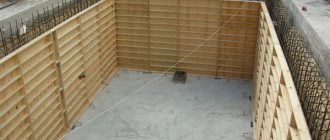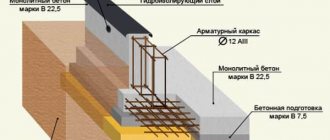There are two ways to level the ceiling: wet and dry. Dry leveling – installation of drywall, installation of a suspended ceiling, etc. The wet method is plastering the ceiling with putty or plaster composition. Plastering is the most common leveling, which will be discussed in the article.
Pros and cons of plaster
Before deciding which is better to choose: plaster or suspended ceiling, it is worth considering the advantages of each option for a specific room. The use of wet leveling is appropriate if the height difference is no more than 50 mm. Since the plaster mixture has a significant specific gravity, falling pieces of heavy plaster finishing can be dangerous. Therefore, if the difference in height of the ceiling surface is large, they resort to dry leveling.
If the construction flaws are minor, the surface is almost flat, there are only small cracks and crevices, the ceiling surface is puttied, applying a layer of 3-4 mm. In intermediate cases, leveling is performed by plastering.
Advantages of plastering:
- strength,
- monolithic coating,
- environmental friendliness,
- washability;
- no frame required
- long-term operation,
- maintainability,
- doing it yourself is cheaper than a stretch ceiling,
- the decrease in room height is insignificant.
Minuses:
- limited coating thickness;
- Some work skills are required;
- can be expensive if you hire specialist plasterers.
The question of what to choose - plaster or suspended ceiling - was resolved in favor of plastering. Let's consider the following question.
Materials for leveling ceilings
Everything is clear with the tools, now we need to consider the materials that are needed to complete the work.
This accessory will definitely come in handy if you are going to work with plaster.
How to properly plaster ceilings, choosing a mixture
The correct choice of plaster composition is especially important for plastering the ceiling.
The main things that must be ensured:
- strong adhesion of the coating to the ceiling surface;
- the solution should not create difficulties during application (be too sticky or fall off the base);
- the quality of the mixture must be maintained until hardening begins (delamination or the start of setting before the guaranteed lifespan is unacceptable).
You also have to choose between a ready-made mixture and a homemade composition. In ready-made mixtures (mineral ones are usually sold in powder form), the composition of the components is carefully selected, which includes all the necessary additives, fillers and binders. Homemade compositions are many times cheaper. They are more of a hassle, but if you follow the basic rules, such formulations are not inferior to store-bought ones.
The size of the fractions can tell you what kind of SS (dry mix) the seller offers - putty (fraction size less than 0.3 mm) or plaster (up to 2.5 mm).
When deciding which mixture to choose, you need to remember the climate of the room being plastered. Simple gypsum compositions are not suitable for wet rooms. For a country house where people live only in the summer, it is more correct to choose compositions for the facades.
Cement based
These mixtures are characterized by their low cost, great strength, versatility, water resistance, and durability. Versatile, frost-resistant. These are the advantages. The disadvantages include instability to vibration loads, a long time to gain strength, and the hardening solution easily becomes covered with cracks if the rules for preparing the mixture and hardening are violated.
The main type of cement used as a binder is Portland cement. Other types are also used. Lime is often added to cement mortar to increase plasticity. There are also cement-polymer mixtures. In decorative compositions, the binder can be white Portland cement.
The specific weight of the solution is higher than that of the gypsum mixture. The maximum thickness of the applied layer is less than that allowed for gypsum. Fits well on concrete base.
Gypsum based
Probably the most favorite type for plasterers. Gypsum sets very quickly and gains strength. The advantages include the low weight of gypsum plaster, plasticity, naturalness, versatility (suitable for most base materials), non-shrinkage, good vapor permeability, low thermal conductivity, and maintainability.
The main disadvantages are fear of water, rapid setting, low frost resistance. As a binder it combines well with lime. There are also gypsum polymer mixtures.
Clay based
The material is cheap, natural (you can scoop it up almost under your feet). Time-tested. Waste-free (dried clay can be easily soaked and used again). Creates a comfortable microclimate in the room. The best choice for finishing a wooden ceiling. Absolutely harmless. Clay plaster can even be applied by hand. Together with sawdust or straw it creates warm walls.
Disadvantages: it takes a long time to dry, which is why there is high humidity in the room, the permissible minimum layer is 10 mm, it gets wet with abundant long-term moisture.
Modern compositions
Although polymer solutions are expensive, they are strong, durable, and elastic. Their adhesion is higher. Sticks to almost all types of substrates. They are easy to install, quickly gain strength, and are not afraid of vibrations and shrinkage of the building. They are not afraid of moisture and are resistant to aggressive substances.
These include:
- acrylic,
- silicone,
- siloxane,
- polymer cement compositions.
They are usually applied in a layer of up to 3 mm, so they are only suitable for smooth surfaces.
How to level it?
Experts recommend leveling with gypsum-based compounds: they are lighter than cement ones and almost never crack or crumble after drying. Such mixtures are available in the form of a dry powder.
Nuances:
- Compositions with a gypsum base dry quickly, so the amount of mixed solution should be such that it can be applied and leveled within 20-40 minutes.
- Mixing basins and buckets, tools must be washed after each kneading. The water must also be clean.
- In warm water, the finished mixture hardens faster. The most suitable is water at room temperature.
- After final mixing, water or dry mixture must not be added to the solution.
- Coarse-grained plaster is applied in a layer of at least 5 mm. It can be applied in several layers, but each one must dry thoroughly before applying the next one.
- The finished solution is applied to the ceiling by moving towards you.
- To level the composition, the rule must be kept with the beveled edge towards you. The thickness of the layer will depend on the angle of inclination of the rule: the steeper it is, the thinner the layer.
- Irregularities in the area where the walls and ceiling meet are smoothed out with a hard spatula.
- If for leveling it is necessary to apply a second layer of plaster, then the first layer before drying is processed with a plaster comb or a notched trowel to obtain a relief.
- After drying, the last plaster layer is sanded with a float with a plaster mesh attachment or sandpaper and treated with finishing putty.
How to repair cracks?
If, after the layers of plaster have dried, defects appear on the surface, they can be eliminated by bringing the surface to almost perfect evenness:
- Small cracks are slightly expanded with a spatula and filled with a special solution. The solution is sold in hardware stores and has the words “crack filler” in its name. After filling the crack with mortar, the surface is rubbed down and leveled into the same plane as the rest of the ceiling.
- In case of deep cracks, the old coating from the damaged area is completely removed. The cleaned surface is primed. After the primer layer has dried, plastering and application of the finishing material are carried out.
Tools and materials
You will need equipment, scaffolding and tools:
- construction trowel;
- a set of spatulas, preferably with rubberized handles (steel, rubber, plastic of different sizes);
- rule or rod with level;
- trowel;
- grater;
- paint brush;
- cord;
- mixer or mortar mixer;
- roller;
- square or rectangular containers for solution (large volume 15-20 l);
- serpyanka;
- sandpaper;
- gloves, mask or goggles, possibly a respirator, overalls.
Let's move on to the next question, no less important for a beginner.
Leveling Tools
In the case when you decide to thoroughly understand the question of how to level old plaster, first of all you should find out what tools are needed for such work. After all, there is clearly nothing you can do here with your bare hands.
You will need:
- Metal spatulas - usually for leveling these elements are purchased in three different types;
- In addition, a container is required (about 15 liters, but no less). It should have a cylindrical shape. The sides should be high so that there is a minimum of splashes during the mixing process;
- To be able to prepare a homogeneous plaster mixture for leveling the ceiling, you cannot do without a special mixer;
- To apply the pre-primer, make sure you have a paint brush and roller;
- You shouldn't forget about the level either. The ideal situation is when its length is no less than 200 cm.
How to remove plaster from a ceiling
Let us immediately note that if the old plaster holds well and has not lost its strength, there is no need to remove it.
Remove completely or partially used coating if it:
- crumbles;
- all covered with cracks;
- “blooming” (covered with mold);
- does not hold well (can be determined by tapping a dull sound) and may fall off.
When partially removing the old finish, you need to remove not only the problem areas themselves, but also the adjacent areas at a distance of about half a meter from them.
First of all, they take out the furniture, cover the floors with film or other materials, and turn off the power to the room. Then tap the entire area with a hammer. As a result, part of the old coating will fall off. Then they carry out the work according to the planned plan.
Standard manual
Use a spatula or chisel, a hatchet, or a hammer. Use a spatula to pry up the edge of the coating, then, using the spatula as a lever, break off a piece of plaster. Sometimes the handle of the tool is tapped with a hammer to drive the spatula deeper under the old coating.
The plaster finish is removed after wetting with warm water (use a brush, cloth, or roller). Allow time to soak, then scrape off with a spatula or scraper.
Finishes made on top of drywall cannot be tapped. Choose a place off to the side and carefully dig out the finishing area down to the drywall. Then, using a scraper, they act similarly to techniques with a spatula, being careful not to damage the cardboard.
They also use a “cunning way” to remove the plaster “casing”: instead of soaking, they use a softening compound. It is prepared like this: 2 tablespoons of starch are diluted in a liter of water. The product is applied with a brush to the plaster coating. After 15 minutes, remove the plaster with a spatula. If not the entire layer is removed, the product is applied again.
The coating, which holds tightly, is removed using a chisel and hammer.
Mechanical approach
How to remove old plaster that is firmly attached to the floor slab? It is removed with a hammer drill, instead of which you can use a drill with a chiselling attachment. A sander is also used (grind down to the base).
Using a grinder, cut the layer of plaster into squares, and then sequentially chip off using a chisel and hammer. The work is hard and dusty. You need stable support and protective equipment.
Removing plaster from the ceiling is a difficult task; you have to work in an awkward position. Therefore, if possible, it is better to leave the old coating.
How to apply the solution correctly?
To prepare a solution for plastering, you need to add water to the finished mixture, as described in the manufacturer’s instructions. The mixture is added to the water, and not vice versa. For stirring you can use:
- special construction mixer (the most effective device);
- a regular drill with a mixer attachment.
If beacons are used in the work, the solution is applied to the space between them.
- The solution is applied with a spatula. The procedure is repeated as many times as necessary so that the surface is completely filled - so that there is a slight excess of leveling material. It is very good when it protrudes a little beyond the beacons.
- Excess is removed with a spatula. To do this, the tool must be moved along the surface in a zigzag manner, moving it towards you. You should not make a layer thicker than 2 cm.
- After treatment, you must wait some time, as the layer must dry completely, and then you can begin to reapply the solution.
To increase the strength of the coating, it is necessary to place a mesh between the layers. It is placed after applying the base layer of mortar and before it dries, and then it is slightly rubbed with a plaster composition.
How to do it without beacons?
Masters recommend plastering without beacons only if a person has not only extensive experience in finishing work, but also an excellent eye, developed over the years or given by nature. Beacons not only help create a more even surface, but also save significant time. If they are not used, repair work will take longer, since defects that arise during work will have to be eliminated.
Plastering without beacons requires small areas. When working with a large area, the error will be quite significant. Plastering is performed in a circular motion within one square. A small rule is best suited for this. The irregularities will be less noticeable than on the walls, so working with a ceiling without beacons is a little easier.
Attention
To plaster ceilings without beacons, experts advise using a thicker solution than for walls. It is not thrown onto the surface, but carefully rolled out with a spatula or a small rule.
To control the evenness of the application of layers, it is necessary to stretch the thread between the nails on the ceiling. A small lamp hanging on the wall near the ceiling will also help. Thanks to the play of light, you can see the slightest irregularities and correct them in time. The lamp should be located to the side of the space being treated. Any detected error must be corrected immediately.
How to plaster a ceiling correctly
To prevent cracks from appearing on the plastered surface, stains of various origins, and areas falling off, plastering must be done correctly.
So it's correct:
- prepare the surface to be plastered,
- select the composition and mix the solution,
- plaster,
- dry.
The thickness of the plaster layer is selected in accordance with the type of composition, base material, and degree of curvature of the ceiling surface.
So the minimum and maximum layer thickness for various mixtures is:
- for cement mixture – 10-50 mm;
- for gypsum – 15-25 mm;
- for gypsum-sand mortar – 10-25 (with reinforcing mesh up to 35 mm);
- for clay-sand – 10-35 mm;
- for clay-cement-sand – 15-35 mm;
- for decorative mortar - 10 (less is not recommended in order to last longer).
Depending on the base material:
- smooth concrete - 2 mm (with differences - 20 mm, greater thickness is made only with reinforcement);
- brick - 5 mm (for leveling - 20-25, with reinforcement up to 50 mm);
- aerated concrete – 2 mm (uneven – 8-15 mm);
- insulation using serpyanka - two layers in the amount of 25-35 mm (under serpyanka 15 mm, on top 10-20 mm);
- wood (two layers), top layer – 15-20 mm;
- drywall – 1.5-10 mm.
If the thickness of the plaster layer is less than 6 mm, then plastering is carried out without beacons. If, after plastering, you plan to stick wallpaper on the ceiling, the surface of the plaster layer is rubbed and sanded.
Surface preparation
Old wallpaper, paint, screws, nails and other metal parts are removed. You also need to remove the whitewash and old plaster coating. The surface is cleaned of dust.
A beginner will need to know how to repair cracks in the ceiling, seams and other defects. Cracks and seams are opened, sand and dust are cleaned with a metal brush. After removing the dirt, apply a deep penetration primer with a brush. After waiting 24 hours, apply a layer of cement mortar into which the reinforcing mesh is embedded. Apply the solution again on top of the mesh with a notched trowel, allow it to dry completely, and apply a second layer.
Removing whitewash and sealing cracks
Traces of rust, mold, and fungus are removed by wetting a sponge. Then they are treated with special compounds. cement mortar
Primer
The ceiling is primed before plastering with compounds that are suitable for both base and mortar materials. For example, a smooth concrete ceiling is coated with a concrete contact primer to increase adhesion. To prime porous materials that can draw water from the plaster mixture, use a deep penetration agent. The composition is applied with a roller in two passes. Each layer is dried for 24 hours.
Preparation of plaster mixture
The composition is prepared immediately before plastering. The prepared mixtures are mixed before use, if necessary, water is added, not exceeding the volumes indicated on the package. Dry mixtures are poured into a container filled with water (the volume is specified by the manufacturer). Mixing is done with a mixer until a homogeneous mass is obtained.
The solution is covered, allowed to stand for 20 minutes, and stirred again. For mechanized ceiling plaster, the mixture is poured into a special compartment. The mixture is prepared automatically.
Installation of beacons
Before installing the beacons, their installation lines are drawn and the ceiling is hung to check the accuracy of its plane. Nails are driven into the corners, the heads of which are spaced from the surface by the thickness of the plaster coating (approximately taken to begin with).
A wire cord is pulled tightly over the caps, along which the presence of bulges is checked. Any bulges found are cut down. If this cannot be done, pull out the nails to the height of the convex + the minimum permissible thickness of the plaster layer.
Pulling the wire cord
A nail is driven in at a convex place, according to which, using a rule with a level on the line for beacons, a nail is driven in, beginning to form a horizontal plane of the future ceiling surface. Having installed the first nail on the beacon line, hammer the second nail on the same line, making sure that the heads of the second and first nails lie on the same horizontal line.
After filling the number of nails required for installing the beacons, they begin to install metal, wooden or plastic beacons, or to make beacons from mortar. To install beacon strips, mortar marks are applied along the marking line. Under the cord stretched between the outer nails, a beacon bar is installed, recessed into the marks, so that its top is in the same plane with the stretched cord.
Installation of a metal beacon
The plank is either secured with gypsum mortar or nailed down. The cord is removed.
When making beacons from mortar, a rule or wooden strip is installed on the nail heads. As a rule, the solution is applied along the entire length. Place a square spatula perpendicular to the ceiling surface and use it to cut off the mortar protruding from under the lath (on one side and the other). As soon as the solution has set a little, the rule is carefully removed. A mortar beacon of rectangular cross-section remains on the ceiling surface.
Making a lighthouse from a solution
To prevent the rule from pulling the solution along with it when removed, it is lightly tapped in the longitudinal direction.
The distance between the beacons is approximately a meter to one and a half meters. For beginners, it is better to place beacons more often. Beacons (except mortar ones) are removed after plastering.
Plastering the surface
There are several technologies used to plaster the ceiling. The mixture is applied by throwing or spreading. Apply the solution with a trowel. If plastering is carried out without beacons, then the composition is applied with a spatula, spreading the mass over the surface. Having applied the first layer in this way, it is dried. Then a second layer is applied. When the applied solution has set, the ceiling surface is washed. Do this with a wet sponge, making circular movements without pressing.
Ceiling plaster technologies
Finishing layer
The ceiling to be painted should not just be flat, but smooth. Visible pores that will appear after staining are not allowed. If you are plastering the ceiling with your own hands before painting, then the plastered surface is covered with a thin (up to 3 mm) layer of coating or finishing mixture. It is more plastic, and its consistency is thinner.
Applying the final layer of plaster and grouting the ceiling
Apply it with a trowel or spatula, holding the tool at an angle. Wait until the covering hardens a little, level it by running a grater over it, removing excess from the tool. This operation is called ceiling grouting. On convex places, the tool is lightly pressed. First, the movements are performed in a circular manner, and at the next stage - in a straight line, without pressing. After grouting, the ceiling plaster for painting is dried and sanded with sandpaper.
Plastering the ceiling with a gypsum-based composition: step-by-step instructions
First stage. The room is being prepared for work. All unnecessary items that can be removed are removed from the room. Then they will not have to be covered, and they will not interfere when moving around the site.
Second phase. Prepare a container suitable for mixing the required amount of plaster. This container must be clean. If another solution was once mixed in it, traces of it should be removed in advance.
Container for mixing the mixture
Third stage. It is necessary to first prepare the ceiling surface itself. First, the sealing is carried out:
- interpanel seams;
- large recesses;
- deep potholes.
Cleaning the ceiling surface
Fourth stage. You can start priming the ceiling. First, use a deep penetration primer. In this way, cracks and pores that are present on the concrete surface are impregnated.
Priming the ceiling using a roller
Maximum adhesion of the mortar to concrete (the slab may be smooth) is facilitated by the use of a primer composition with special properties. This “concrete contact” is used to treat a concrete slab.
Betokontakt PUFAS
The structure of the applied composition helps to achieve a good result: the primer contains fine-grained quartz fillers. The result is a distinctly rough surface that perfectly holds the plaster even on a horizontal plane. This composition is thicker than a regular primer.
“Concrete contact” is applied with a brush or roller. If you are working on a hard-to-reach area, then a brush is more suitable.
Fifth stage. A system of beacons is set in order to create a flat plane, ideally horizontal. After all, the elements of the interfloor ceiling may have different levels; these shortcomings are allowed by the builders.
The easiest way to mark with beacons is to use a laser level (plane builder). Plaster beacon profiles made of steel are used. Parts 3 m long and 0.6 cm high are suitable for processing ceilings.
Displaying beacons on the ceiling
Lines are drawn on the ceiling surface for placing beacons along them. The distance between the lines is marked, taking into account that the rule should be 25-30 cm longer, this is at least.
Using a 10 cm wide spatula, “patches” of the plaster composition are applied along the intended line. Beacon markings are made along the intended line, the beacons are sunk into the mounds of solution.
Sixth stage. Prepare the plaster solution in the required quantity. It is advisable to attach a rule to the self-tapping screws of the lighthouse in order to set the “patches” of the solution in the desired direction.
Beacons are installed in plaster slides
Using small strokes along the marked line, mark the places where the solution slides will be located. They will be located at a distance of 15-20 cm from each other. The rule is removed to the side and “patches” of the solution of the required thickness are applied. The thickness should be slightly greater than the height of the screws protruding from the ceiling.
A beacon profile is sunk into the formed slides. It should be held securely enough. After this, use the rule, applying it to the beacon profile along its entire length.
The rule is pressed, then the profile is immersed in the slides of the solution. The pressure limit is the moment when the profile begins to rest against the heads of the screws. And then the profile will be able to take a position that is considered ideally horizontal, resting on the heads of the self-tapping screws, set according to the level.
Next, carefully select the solution using a spatula and clean the working surface of the profile from adhering plaster.
Seventh stage. The preparation of the beacon system is complete. You can work further: prepare the plaster solution for the subsequent, main operation.
The dry construction mixture is poured into a container with water. Kneading is done using a construction mixer. It will be necessary to achieve absolute homogeneity so that even small lumps are not detected. After reaching the required consistency, a pause is made, the solution is left to “ripen” for 3-5 minutes.
Mixing putty with a mixer
Next, this composition is applied to the ceiling surface - to those areas located between the beacon profiles. You can use different application methods. People with experience often use the method of sketching plaster with a trowel (trowel).
Eighth stage. The plaster solution is distributed and leveled using a rule. Landmark: lighthouses.
The solution is applied to the sections of the ceiling between the beacons
Using a spatula, remove excess solution from the rule plane. It will be used to fill other identified problem areas. This work is repeated many times until a surface leveled with the beacons is obtained.
Ninth stage. After plastering the entire ceiling surface, the solution should set completely. It's time to remove the beacon profiles.
For your information. You should remove profiles in any case. Otherwise, rust will appear over time. In addition, the expansion of gypsum plaster and metal is absolutely incomparable. This means that over time, cracks will appear along the line of the lighthouse.
Tenth stage. The places where the profile was removed are aligned with the general ceiling level. Use a wide spatula.
Eleventh stage. When the solution has set well, you will need to follow this line:
- washing;
- glossing.
Then the surface takes on a perfectly smooth appearance. The ceiling becomes smooth, level differences disappear.
For step-by-step puttying of a plasterboard ceiling, see the article.
Video: How to quickly plaster a ceiling:
(No Ratings Yet)
Step-by-step instructions for plastering the ceiling with illustrations
- First stage: prepare the room, remove the layer of old plaster, clean the surface, repair
- We remove furniture from the room and cover the floor with film.
- We de-energize the room.
- We remove old finishing (wallpaper, paint, whitewash).
- We remove metal objects (screws, nails). We insulate the remaining ones with oil paint so that they do not rust as a result of contact with the solution.
- Use a wet sponge to wash off mold, efflorescence, and rust.
- We treat stains with special products.
- If there is an old plaster coating, we remove it, not forgetting to wear goggles and a respirator to protect the eyes and respiratory organs. There are several ways to remove the coating (see above).
- Clean the surface from dust.
- We repair cracks, seal seams and holes in floor slabs with cement mortar. We embroider wide seams and cracks, clean them from dust, prime them with a brush, and fill them with foam or rags with a solution. We plaster with a solution with a reinforcing mesh (serpyanka will not work).
- We dry it and wait for the cement mortar to dry.
Removing old finish from the ceiling surface
The quality of the preparatory work determines how firmly the plaster coating will hold, as well as the appearance of the entire room (whether cracks will appear and stains will appear on the surface.
- Second stage: before plastering the ceiling, prime the surface
- We prepare the primer according to the manufacturer's instructions.
- Scooping the primer onto a roller, transfer it to the surface to be primed, distributing it evenly with straight-line movements in one direction, leaving no gaps. Where it is difficult to handle with a roller, we use a brush. We wait for the applied primer to dry completely.
- Apply the second layer, moving the roller in a direction perpendicular to the previous application. Give the primer time to dry.
To increase adhesion, be sure to prime the prepared surface.
Priming the surface not only increases the adhesion strength of the plaster finish to the ceiling, but also strengthens the base itself. Affects the duration of trouble-free operation, solidity, and durability of the finish.
- Third stage: installing beacons
This operation determines how smooth the ceiling surface and the appearance of the entire room will be. In addition, it determines the consumption of plaster materials.
- In order to evenly plaster the ceiling part of the room, we determine the “plane of the ceiling horizon” and create landmarks for the surface of the coating - beacons (see above). We purchase metal or wooden profiles.
- We attach a laser level gauge to the wall at the lowest ceiling corner. We will use it to orient the top of the lighthouse strips.
- Using a tape measure and a plane illuminated by a laser, we find the lowest point of the ceiling. You can also determine this point using a cord. Mark the point with a pencil. It will be decisive for the placement of beacons in height. The minimum height of the beacon profile is 3 mm, the total thickness of the coating is 6 mm. This means that the top of the planks should be 6 mm below the point.
- Apply with a pencil to the surface of the beacon attachment line. We select the distance between them so that it does not exceed the length of the rule minus 20 cm.
- To fix the plank along the line, we make marks - patches of gypsum solution. We apply the profile to the stamps, recessing it so that the top exactly coincides with the “horizon plane”. Remove excess mortar protruding above the profile with a spatula. We give the solution time to get stronger and begin installing the beacon on the next line.
- If the thickness of the future coating exceeds 2 cm, install a reinforcing mesh.
Laser level mount
Determining the lowest point of the ceiling
Drawing a pencil line for attaching beacons
Beacon installation
- Stage four: preparing the SS mortar for plastering
- Pour water into a square container intended for the solution in an amount slightly less than indicated on the package.
- Add all the mixture that is in the package.
- Dip the end of the mixing attachment into the mixture and turn on the mixer. Mix the contents of the container until the mass becomes homogeneous. If the dough turns out to be thick, dilute it with water to the desired consistency. At the same stage we add color if a colored solution is needed.
- Cover the mixed solution with film or a lid. Let it “infuse” for 20 minutes. Then mix again.
We produce the prepared solution until the end of its life - 40 minutes
- Fifth stage: plaster the surface.
- We begin to apply the plaster solution between the two beacons (the first and second from the edge, and not between the corner and the first beacon). Fill with solution
- As professionals recommend to beginners, when applying plaster to the ceiling, first apply a thin contact layer and immediately on top of it - the main amount of the solution, which is already coming out on top of the beacon strip. The use of a contact layer reduces the amount of waste (falling off the surface of the solution).
- Using the rule, pressed against the beacons, moving towards you, we stretch the solution. The excess mass, which is removed according to the rule, is collected from it with a spatula and sent to where there is not enough solution. We usually do this several times until the entire surface is level.
- We continue plastering the ceiling along the beacons in a similar way until we can plaster the entire surface. To level the solution between the outermost beacon and the wall, we usually rest it on two nearby beacons.
- We wet the sponge with water, moisten the surface of the set solution (we use the sponge without pressing).
- Gloss the surface with a wide spatula.
- Use a spatula to pry up the beacons and remove the planks from the solution.
- Fill the grooves with mortar, leveling with a wide spatula. We also wet and gloss it. Plastering on e is completed.
Application of contact layer
Applying the main amount of solution
Stretching rule solution
Leveling the solution using the rule
Removing planks from the solution
Filling grooves with solution
Ceiling preparation
With “wet” methods of leveling the ceiling, you need to be especially careful when preparing the base, because mistakes made at this stage can lead to peeling of the plaster in the future.
- Removing old plaster - if the ceiling has already been plastered, then the coating does not always need to be removed. This issue is resolved separately for each specific case, since this procedure is quite labor-intensive if you do the ceiling leveling yourself. If you hire a professional, dismantling the old coating will increase the cost of the work.
To make a decision on old plaster, it is necessary to carry out diagnostics. The reason for removing the finish may be cracks on the surface or mold stains. You should also try to tear off the coating with a spatula; if it begins to crumble, the plaster will have to be removed. You can also tap the plaster for diagnostics. If the surface “swells”, then voids have formed underneath, such a layer will be a poor base for a new finish.
To remove old plaster, you can use a hammer drill, axe, hammer or narrow spatula.
- Washing off the whitewash is a mandatory procedure before plastering work. Whitewash was commonly used in older homes. Lime whitewashes are especially dangerous: over time they crystallize and lose adhesion - the weight of the plaster can tear it away from the base.
- Cracks must be repaired using plaster or putty. You also need to add reinforcement; perforated tape or sickle mesh is suitable for this.
Read more about sealing cracks with putty in the article » » on the website.
- Sealing rust - this architectural element spoils the appearance of the ceiling, so it must be dealt with in the same way as with cracks. Before embedding, it must be expanded by 2-3 cm. To do this, you can use a hammer drill. Then the recess is filled with polyurethane foam and puttied. A serpyanka mesh is glued onto the putty layer, then a finishing layer of putty is applied on top.
How to level a ceiling with plaster
If the surface is too far from ideal, leveling is done by plastering the ceiling along the beacons. To install beacons, a laser level gauge is used, usually with a level. If the surface is almost flat, leveling is done without beacons.
Relatively flat ceilings
Relatively smooth ceilings are plastered in several layers (two, sometimes three). In this case, one of the layers can be partial (selected areas are plastered), the second must be complete. If the layer thickness is more than 1 cm, reinforcement is used. The mesh is fixed to the surface under tension before plastering begins. It should be inside the plaster layer.
Ceilings with large unevenness
If the ceiling surface has large irregularities (more than 2 cm), plaster the ceiling along the beacons. The composition is applied with a spatula (a medium-width tool is used) so that the mixture protrudes above the beacons. Moving the rule in a zigzag manner, level the applied mixture. The excess is removed from the rule and thrown onto areas that need to be replenished. The rule is moved towards itself.
How to choose a putty composition for the ceiling?
There are finishing and starting putties. The former have a finer grain fraction, so they can be applied in a thinner layer. The starting putty is usually laid in a layer of 10 mm to 30 mm. The finishing layer has a thickness of no more than 0.5 - 1 cm.
Also, putties vary depending on the initial readiness. Ready-made mixtures are supplied in buckets and are immediately ready for use; dry mixtures must first be mixed with water. Ready-made compositions have the finest fraction, so they are designed for laying in a thin layer. Also, ready-made formulations are not suitable for storage at subzero temperatures. Dry mixtures are more suitable for laying in a thick layer, so they are more convenient for “rough” leveling of various surfaces.
When choosing a putty, it is important to consider the conditions in which the room will be used. For wet rooms, it is better not to use gypsum-based compounds; in this case, it is better to use cement mixtures.
Some features of plastering other ceilings
There is no single answer to the question, “how to plaster a ceiling?” it can not be. Everywhere has its own nuances.
Wooden ceilings
You need to prepare in advance for plastering a wooden ceiling. Two layers of shingles are stuffed onto the ceiling or a metal mesh with 10x10 cm cells is attached. Without this, the plaster layer will crack and weakly adhere to the wood.
Each of the two applied layers is dried. The first one is applied so that it rises slightly above the shingles. The layers are leveled with a spatula.
How to plaster a plasterboard ceiling with your own hands
Drywall itself is a finishing finishing material. However, joints and nail heads may appear after painting or wallpapering. The plasterboard ceiling is leveled using sickle coating on the seams. The layer thickness should be no more than 15 mm.
Plaster on ceiling insulation
Sometimes sheets of insulation (usually polystyrene foam) are attached to the ceiling surface for insulation. Then plastering over the insulation is carried out in two stages. First, the surface of the insulation is primed. Then a layer of a more liquid mixture is applied over the dried primer, onto which a painting mesh is applied, lightly pressing it into the layer. The mesh panels are overlapped. After the first layer has dried, the surface is primed again and, after the primer has dried, a second layer of a more viscous solution is applied. Work with this layer as usual.
Ceiling putty
The putty can be applied with or without beacons. In most cases, putty is applied after plastering to complete the leveling for painting. If you apply putty without plaster, this will significantly increase the consumption of material.
The starting putty is usually applied in several layers. The first must dry before applying the second coat. After drying, the surface is treated with sandpaper. To do this, it is convenient to fix the sandpaper on a grater or wrap it around a block. With this tool you need to make circular movements along the surface of the ceiling.
Read more about puttying walls in the article “” on the website.
To apply the composition to the ceiling, use two spatulas (wide and narrow) or a spatula and a trowel. It is better to move the tool diagonally so that the layers overlap.
The finishing putty is applied after the starting layer has dried; it is needed if the surface is to be painted.
Application of decorative plaster
Finishing the ceiling with decorative plaster is difficult due to the inconvenience of the position, but not the technique. The techniques used are the same as for decorative plastering of walls. For beginners, it is better to practice on the walls. But if you have successful experience, why not try to do the same with the ceiling?
Start from any corner of the room, plastering a strip along the wall. To prevent the solution from flying off, immediately spread it on the ceiling. Apply the pattern using the chosen method. After plastering is completed, the finish is dried. If the decorative composition is not tinted, then the next stage of work will be sanding, then painting the ceiling (you can also do waxing).
Ceiling markings
At this stage, you need to measure the horizontal level of the new ceiling. To do this, you need to find the most protruding point on the old base. To do this, you can use a long rule or a bubble level. The level must be applied in different directions and the readings checked. From the most protruding point we measure the thickness of the future ceiling and mark it on the wall. Then this mark must be transferred to all walls. To always see the level, you can screw self-tapping screws into the wall and stretch a rope between them. You can also leave a line on the wall using thread and paint.
If you have a laser level, then measuring work is greatly simplified. The device allows you to project a laser beam onto all walls in the room.
Manufacturers and consumption
As a rule, it is difficult for a beginner to correctly navigate what to plaster and which plaster is better. Therefore, it is easier to rely on the advice of professional plasterers, as well as the reputation earned by popular brands. For example, mixtures from the companies Ceresit, Knauf, Volma, Bolars, Prospectors, and Plitonit are worthy of attention.
To ensure that plastering work does not have to be interrupted due to a lack of building materials, the approximate volume of required leveling plaster and putty for the ceiling is calculated in advance. Plaster consumption is calculated using a simple formula, multiplying the area of your ceiling by the average thickness of the coating. The average thickness value is obtained by summing measurements at several points along the beacons and dividing the sum by the number of measured points.
The resulting number is increased (in reserve) by 20%. This is for beginners. Pros increase by 5%. Divide the volume of the mixture you need by 100, you get the number of conventional squares (layer thickness 10 mm). Next, based on the manufacturers’ data, calculate the number of packages of the mixture that you need to purchase to level the ceiling with plaster yourself. For mechanized ceiling plaster, the consumption is slightly less. Our online leveling plaster calculator will help you with the calculations.
Applying plaster
For further work, you need stable construction sawhorses, and the tools you need are a spatula and a platform with a handle (falcon). The selected plaster composition is diluted in accordance with the instructions. It is necessary that the solution is homogeneous, without lumps.
The putty is spread on the falcon and placed on the ceiling in small portions using a spatula. The solution is used to fill the distance between the beacons. First, the width of the strip is made from 50 to 60 centimeters, and there is no need to achieve a uniform surface.
Then they take the rule, rest it on the beacons and move it towards themselves, swinging it from one side to the other. As a result, a little solution remains on it. It is removed with a spatula and applied to the ceiling - to its unfilled part or where there are holes. Then the rule is moved again.
These steps are repeated until the surface area becomes level. Then they fill in the second lane and so on. The ceiling is allowed to dry for 5 – 8 hours. When the solution has set, but has not yet completely dried, you need to remove the beacons, otherwise they will rust and rusty stains may appear on the surface.
The rustics after the planks are filled with mortar and leveled with a wide spatula to the same level as the ceiling plane. It takes about 5 – 7 days for the plaster to dry completely.
Mistakes made at work
A particularly common mistake is failure to adhere to ceiling plastering technology. The result may be the appearance of shrinkage cracks, swelling, falling off of pieces of coating, and low strength. If the plaster has fallen off, the reason may lie in poor adhesion or poorly sealed seams and cracks.
Stains on colored plaster may appear as a result of breaks or purchasing compositions from different batches. Shrinkage cracks can occur due to drafts during drying or excessively hot weather.
The rules of plastering cannot be neglected.
With or without beacons
There are two technologies for ceiling plaster - with and without beacons. The right thing to do is to do it with beacons. Then the ceiling surface is in one plane. However, there are ceilings with very large height differences. Throwing a 5 cm thick layer of plaster on the ceiling is dangerous: it may fall. Even if you make several layers with a primer after each, there is still no guarantee that such a large layer will stick.
Incorrectly applied plaster can cause everything to collapse.
In general, if the ceilings have a large curvature, it is recommended to level them with suspended ceilings made of plasterboard, but not all rooms allow you to “steal” about 10 cm of height. In this case, you can do it wrong - plaster the ceiling without beacons.
The whole idea is to make the ceiling smooth in some area. It will not have noticeable differences and will visually look smooth. And the fact that in different corners the distance to the floor will differ by several centimeters cannot be determined by eye. With this technology, the main task is to make the junction of the ceiling and walls even. This line is very clearly traced and should be straight. If you choose this technology for plastering the ceiling, you need to start plastering from the walls, towards the center.
Coating repair and care
Caring for the plaster coating is simple. The surface of many modern compounds can be washed with a damp cloth, sponge or soft brush. If the plaster is damaged somewhere locally, it can be repaired using the appropriate composition. Before repairs, the area is dusted and primed. After which the mixture is applied with a spatula and leveled.
This article answers a number of questions that a beginner has when starting repair work. To answer the main one - “how to plaster a ceiling?” is impossible without answering more specific questions, for example, “which ceiling is better, suspended ceiling, plasterboard or plaster?”, “Which is better from plaster mixtures – gypsum or cement?” etc. We hope that after reading the article, you learned all the most important things about how to plaster a ceiling. Missing information, for example, on coloring, can be found on other pages of the site.
Materials
Before starting repairs, you need to decide how best to plaster the ceiling. You can use a standard cement-sand mortar or add lime to it. It is better to apply the plaster in a small layer. This mixture turns out to be inexpensive, despite this, it is used infrequently recently, since it can fall off or become cracked.
Instead of conventional mortar, it is better to use polymer-based plasters, since they have strong adhesion and are less likely to crack. But these compositions have a drawback - high cost. Many home craftsmen prefer modern mixtures, so as not to have to redo the work later when the applied layer falls off.
When choosing plaster for the ceiling, it doesn’t hurt to use the recommendations of experts:
- When plastering smooth surfaces of ceilings and walls, the Knauf Rotband mixture, which has a white or gray color, has worked well. It can be applied in a layer of 5 to 50 millimeters. Polymers are added to this gypsum ceiling plaster.
- To restore old plastered surfaces, including facades, the gray Knauf Sevener plaster-adhesive mixture is suitable. Consists of Portland cement, reinforcing fibers and polymer additives.
- If you plan to use the compositions in rooms with normal humidity levels, you can purchase Bergauf Bau Interier or Volma-Canvas.
If you have insufficient experience in carrying out such work, when deciding which plaster to choose for the ceiling, you should pay attention to the time it takes for the mixed mixture to harden. During this period, it is necessary not only to apply the solution, but also to level it, since then it loses its elasticity.
Of the above-mentioned plaster compositions, Volma-Holst, made from gypsum with biological and mineral additives, has the longest time period for using the mixture. But not all craftsmen like to work with this plaster; they use TM Knauf materials, despite the fact that they harden in 50 - 60 minutes. True, this is quite enough, even if there is no relevant experience.
Advantages and disadvantages of plaster
Among the advantages of plaster are the following characteristics:
- Cost-effective (if you decorate the room exclusively on your own, plastering the ceiling will not cost you a pretty penny);
- Versatility (you can plaster a ceiling made of any materials - from concrete to wood);
- Hypoallergenicity (due to the natural origin of the components of this mixture, it will be safe for people suffering from a variety of allergic diseases);
Flaws:
- Cannot be used when ceiling differences exceed 5 cm (in this case, plastering will pose a health hazard, since a thick layer can fall off at any time);
- Quite capricious in work, requires certain skills;
- If you resort to the services of professionals, the repairs will cost a large amount;
How to prepare a ceiling for plastering
The easiest way to make repairs is if you bought a room in a newly built house. You can plaster a reinforced concrete slab in a new building in a short period of time. But most often situations arise when it is necessary to repair the ceiling after numerous paintings.
Plaster prices
plaster
Making notches on the ceiling
The work is complicated by the fact that in most cases you have to deal with mold and large differences. In addition, to form a smooth ceiling, it is necessary to remove deep cracks that can often be observed between the slabs. It is impossible to make the ceiling level if you see that the old plaster has chipped or is crumbling. All of the above shortcomings need to be eliminated; only after that does it make sense to begin repair work.
Table. Removing old plaster.
| Steps, illustrations | Description of actions |
| Step 1 | First you need to wet the ceiling well with water. Once done, wait 2 or 3 hours and then wet again. This method is very effective. Firstly, you will remove dust from the surface and it will be comfortable to work with. Secondly, the old plaster will soften well. |
| Step 2 | Take a hard spatula and use it to remove the old plaster, carefully scraping it off the surface. Remove the plaster until the concrete floor appears. If the plaster does not come off easily, use a hammer drill. Pay special attention to the seams between the plates. |
| Step 3 | Rinse the ceiling thoroughly. This can be done with a sponge, which must first be moistened in water. This will effectively remove dust remaining from lime or cement. |
| Step 4 | Allow time for the ceiling to dry. Buy an antiseptic solution and apply it to the surface - this will remove the fungus and prevent the appearance of mold. The antiseptic should be poured into a separate container. To apply it to the surface, buy a foam roller. When renovating, many property owners apply antiseptic only to the affected areas. But experts recommend treating the entire ceiling with an antiseptic solution. The cost of purchasing an antiseptic is minimal, and the effect of its use is long-lasting. It is best to use an antiseptic primer. |
| Step 5 | After applying the antiseptic solution, wait until the ceiling is completely dry. After this, apply primer. Choose one that penetrates deep into the pores. This material has excellent adhesion, significantly strengthening the surface. |
Necessary mixtures and building materials
The market of modern building materials offers the consumer a wide range of different mixtures for plastering surfaces of any type. And all that remains for a person who is planning to start a renovation to do is not to make a mistake in his choice. The quality will depend on this .
Just a few decades ago, the most common material for carrying out work of this class was considered a mixture of cement, sand and lime. This solution was applied in a thin layer; if necessary, the process had to be repeated. And with all the positive aspects of this method, for example, low cost and environmental friendliness, the durability of the solution left much to be desired. Cracks and chips appeared already in the first year after repair. Therefore, it has recently been almost replaced by ready-made dry plaster mixtures based on polymers. One of the most common types of such mixtures is Knauf plaster.
Ready-made mixtures made the work much easier. They allow you to apply a fairly thick layer of material - up to 50 mm, which significantly reduces the processing time of surfaces. The only thing worth considering when working with this building material is quick drying. Since their hardening time is limited, as a rule, it is from 30 minutes to an hour. It is important to consider the time period required to produce one portion of plaster in order to avoid unnecessary waste on dried mortar.
Plastering process
Even if the mixture for final processing is selected to be of the highest quality, you should not completely rely on the fact that it will last a long time. In many ways, the durability of plaster also depends on the hand of a true craftsman.
Preparation of the mixture:
- Pour the amount of warm water recommended by the manufacturer into a prepared container.
- Slowly pour the mixture into the liquid, stirring occasionally.
- Mix the solution thoroughly with a construction mixer until it becomes a homogeneous slurry. Leave to infuse for 15-20 minutes. Mix again with a mixer.
It is recommended to apply the putty with a plastic spatula; you can also use rubber tools, which have recently become increasingly popular. To level the layer, it is better to use special metal tools. It is recommended to dry each layer for 16 to 24 hours.
